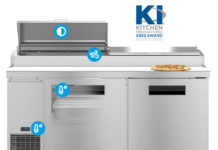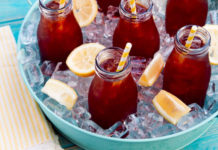 When it comes to profitability, bar design matters. Choosing the best setup and equipment for your particular space affects the success of your operation.
When it comes to profitability, bar design matters. Choosing the best setup and equipment for your particular space affects the success of your operation.
“Bars differ in the types of beverages they offer; the shape, size, and configuration of the bar space; and the number of patrons they intend to serve during peak times,” says Dave Kearns, Product Marketing Manager at Perlick Corporation in Milwaukee, Wisconsin. “Selection of refrigeration equipment, underbar components, glass washing, and storage equipment are all affected by the variables mentioned. The ultimate goal is creating the most efficient and productive bar the space and budget will allow.”
Service Stations
Specialized service stations can increase bartender efficiency. One of Perlick’s new products is the Tobin Ellis Cocktail Station. “[It’s designed] to be more ergonomic for bartenders and to better accommodate their needs when making craft cocktails,” says Kearns. “It’s specifically dedicated to the efficient production of cocktails in high-volume environments. The Perlick speedrail features a rounded design, allowing bartenders more of a ‘cockpit’ feel in their station. They can be closer to their work counter and guests. It has space for large-footprint bottles that don’t fit in standard speed rail. It’s designed for optimal reach for bartenders to pull bottles from the rail.
“A specially designed refrigeration unit features two low-temperature refrigerated drawers with the industry’s only NSF-rating for open food storage.”
Bar owners should also consider bottle display. “A liquor step module in a variety of sizes is advisable at each station or shared by two stations,” says James A. Brown, Sales Engineer at Perlick. “This stock duplicates the most popular call brands displayed on the back bar. It saves wasted motion by keeping bottles close at hand rather than requiring the staff to make two trips to the back bar.”
Glass Washing
Bar Maid Corporation, based in Pompano Beach, Florida, makes a small, convenient glasswashing machine. “The glasswasher that we manufacture actually fits right into a bar sink,” says George Shepherd, President of Bar Maid.
The machine uses five brushes—one for the inside of the glass and four for the outside. “This method of washing glasses is just as fast as loading or unloading a dishwasher,” says Shepherd.
Bar Maid also has a new glass polisher. Similar to the washer, it features five soft brushes to polish each glass with a tube that blows hot air onto the glass to achieve a high shine. “It’s 35 pounds, very portable. It’s already being picked up by a lot of the state chains,” says Shepherd, who points out that the machine can polish up to 400 glasses per hour.
Some companies advocate under-counter glasswashers. “A glasswasher requires less space than a three-tank bar sink, reduces staffing needs, and provides consistently sanitized glassware at a far higher rate than manual washing,” says Brown.
Kearns details the three types of glasswashers that Perlick offers—Door Style (standard and high temp), Carousel, and Batch Rotary.
“They vary in capacity and the way glassware is loaded and unloaded,” he says. “They also vary in the way they sanitize. For example, most of the glasswashers use chemicals to sanitize the glasses, whereas our PKHT24 is a high-temp model that sanitizes the glassware with 180-degree water during the final rinse. At 180 degrees, besides sanitizing without chemicals, lipstick is removed.”
Companies like Moyer Diebel and Glastender also offer glasswashers.
For rinsing bar tools, Naoki Sonoda, a bartender and inventor in Palatine, Illinois, has the solution. “I saw a need for rinsing bar tools in between making drinks—mostly mixing tins,” says Sonoda.
He developed the Omni-Rinse, a machine that rinses the inside and outside of mixing glasses and tins. Requiring no electricity, the machine is simple to use. “The bartender dumps the shaker ice in the unit, places the mixing tins on the Rinse Platform, and presses a button on the side,” says Sonoda, explaining that the machine rinses everything within 10-12 seconds. “By the time the bartender has made another drink, they will have a freshly-rinsed set of tins.”
Refrigeration
Perlick offers numerous refrigerators. For tight spaces, Perlick has compact refrigeration in one or two door models.
Perlick also has pass-through refrigerators featuring doors on both sides. “For certain bar layouts, such as a racetrack designed bar, a pass-through refrigerator in the middle of the track allows bartenders on opposite sides to access packaged beverages without having to walk around to the other side,” says Kearns.
Glastender, a Michigan-based company, offers several underbar coolers with features such as front venting, mug chillers, and pass-through. Low profile and narrow door coolers are available. Glastender also has a refrigerated wine drawer with upright storage.
Other Equipment
Perlick also has a number of underbar accessories such as a compartmentalized ice bin, tool caddy integrated into multi-use sink, storage cubby in front of multi-use sink module, refrigerated storage drawers for cocktail garnishes and fresh fruit juices, soda gun manifold storage locker, curved speed rail with a section for storage of large format liquor bottles, and a slanted speed rack.
According to Kearns, one of Perlick’s most popular products is its forward-sealing beer faucets. “The forward sealing design eliminates the problem of bacteria and mold from growing on the interior wetted surfaces that are exposed to air in between pours,” he says.
For combating fruit flies, Bar Maid has a non-toxic fruit fly trap called the “Fly Bye,” a drip tray strip that blocks fruit flies, and the new Fly-Bye Floor Drain Trap Seal. The trap seal replaces ordinary drain covers. It allows liquids to drain but prevents fruit flies and gases from entering. Since drains are a common fruit fly breeding zone, according to Shepherd, this seal solves the problem and only takes seconds to install.
No matter what type of equipment you need, the top consideration should be your bartender’s movements. “Limiting wasted motion is a key part of maximizing efficiency, productivity, and ultimately return on investment,” says Kearns.
By Emily Eckart
All photos: Perlick.








